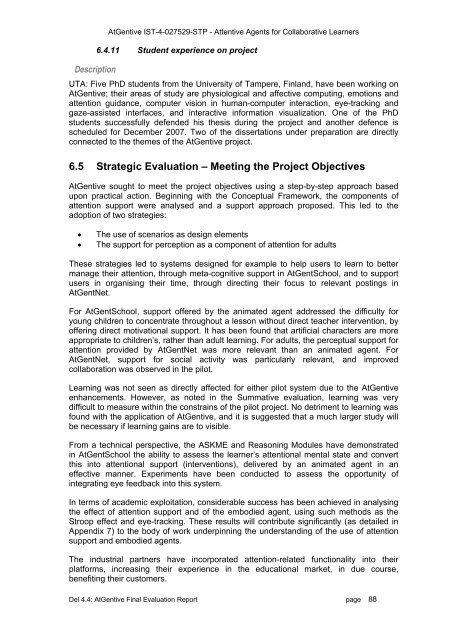Deliverable 4.4 - INSEAD CALT
Deliverable 4.4 - INSEAD CALT
Deliverable 4.4 - INSEAD CALT
You also want an ePaper? Increase the reach of your titles
YUMPU automatically turns print PDFs into web optimized ePapers that Google loves.
DescriptionAtGentive IST-4-027529-STP - Attentive Agents for Collaborative Learners6.4.11 Student experience on projectUTA: Five PhD students from the University of Tampere, Finland, have been working onAtGentive; their areas of study are physiological and affective computing, emotions andattention guidance, computer vision in human-computer interaction, eye-tracking andgaze-assisted interfaces, and interactive information visualization. One of the PhDstudents successfully defended his thesis during the project and another defence isscheduled for December 2007. Two of the dissertations under preparation are directlyconnected to the themes of the AtGentive project.6.5 Strategic Evaluation – Meeting the Project ObjectivesAtGentive sought to meet the project objectives using a step-by-step approach basedupon practical action. Beginning with the Conceptual Framework, the components ofattention support were analysed and a support approach proposed. This led to theadoption of two strategies:• The use of scenarios as design elements• The support for perception as a component of attention for adultsThese strategies led to systems designed for example to help users to learn to bettermanage their attention, through meta-cognitive support in AtGentSchool, and to supportusers in organising their time, through directing their focus to relevant postings inAtGentNet.For AtGentSchool, support offered by the animated agent addressed the difficulty foryoung children to concentrate throughout a lesson without direct teacher intervention, byoffering direct motivational support. It has been found that artificial characters are moreappropriate to children’s, rather than adult learning. For adults, the perceptual support forattention provided by AtGentNet was more relevant than an animated agent. ForAtGentNet, support for social activity was particularly relevant, and improvedcollaboration was observed in the pilot.Learning was not seen as directly affected for either pilot system due to the AtGentiveenhancements. However, as noted in the Summative evaluation, learning was verydifficult to measure within the constrains of the pilot project. No detriment to learning wasfound with the application of AtGentive, and it is suggested that a much larger study willbe necessary if learning gains are to visible.From a technical perspective, the ASKME and Reasoning Modules have demonstratedin AtGentSchool the ability to assess the learner’s attentional mental state and convertthis into attentional support (interventions), delivered by an animated agent in aneffective manner. Experiments have been conducted to assess the opportunity ofintegrating eye feedback into this system.In terms of academic exploitation, considerable success has been achieved in analysingthe effect of attention support and of the embodied agent, using such methods as theStroop effect and eye-tracking. These results will contribute significantly (as detailed inAppendix 7) to the body of work underpinning the understanding of the use of attentionsupport and embodied agents.The industrial partners have incorporated attention-related functionality into theirplatforms, increasing their experience in the educational market, in due course,benefiting their customers.Del <strong>4.4</strong>: AtGentive Final Evaluation Report page 88
















